Thursday, 9 May 2013: Marseille by minibus
Written Tuesday, 9 May 2013
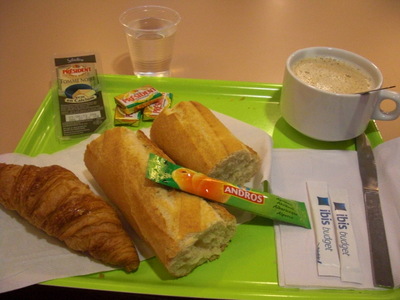 Here's my choice from the entirely satisfactory all-you-can-eat breakfast buffet: A cup of café au lait (i.e., a packet of instant decaf made up with hot milk rather than water—in this case, five presses of the "hot milk" button on the hot drink dispenser), two packets of sugar, three packets of excellent demi-sel butter (ah, real French butter!), a tubular squeeze-pack of apricot jam, two chunks of fresh baguette (which I cut myself to the size of my choice), a single-serve packet containing a thin wedge of "tomme noir" cheese (like havarti in the center but like swiss near the rind), a small but outstanding croissant, and a cup of chilled water. Later, I went back for a second croissant and another pat of butter. Also available were apple and orange juices (from a dispenser), single-serve cups of applesauce and plain yogurt, two kinds of dry cereal, cold milk, a bowl of cut-up fresh fruit, sliced bread (with toaster), cut-it-yourself whole-grain bread in square cushion-shaped loaves, slices of pound cake, tubes of strawberry jam, single-serve packets of honey and Nutella. The hot drink dispenser also did hot water (teabags supplied), espresso, hot chocolate, and "extended" (i.e., dilute enough for Americans) coffee. No plates or forks were supplied—just these green masonite trays, coffee cups, and stainless-steel knives and spoons. The napkins, juice/water cups, and cereal bowls were all disposable. No noninstant decaf, no eggs (either cooked or boil-'em-yourself), no cold cuts, no potato tortilla, no pains au chocolat or aux raisins. So, all in all, a spartan rather than a middling or sumptuous breakfast buffet, but the products supplied were uniformly outstanding. I look forward already to tomorrow's rerun of the same menu, though I may substitute one of the little yogurts, with honey, for the cheese wedge.
Here's my choice from the entirely satisfactory all-you-can-eat breakfast buffet: A cup of café au lait (i.e., a packet of instant decaf made up with hot milk rather than water—in this case, five presses of the "hot milk" button on the hot drink dispenser), two packets of sugar, three packets of excellent demi-sel butter (ah, real French butter!), a tubular squeeze-pack of apricot jam, two chunks of fresh baguette (which I cut myself to the size of my choice), a single-serve packet containing a thin wedge of "tomme noir" cheese (like havarti in the center but like swiss near the rind), a small but outstanding croissant, and a cup of chilled water. Later, I went back for a second croissant and another pat of butter. Also available were apple and orange juices (from a dispenser), single-serve cups of applesauce and plain yogurt, two kinds of dry cereal, cold milk, a bowl of cut-up fresh fruit, sliced bread (with toaster), cut-it-yourself whole-grain bread in square cushion-shaped loaves, slices of pound cake, tubes of strawberry jam, single-serve packets of honey and Nutella. The hot drink dispenser also did hot water (teabags supplied), espresso, hot chocolate, and "extended" (i.e., dilute enough for Americans) coffee. No plates or forks were supplied—just these green masonite trays, coffee cups, and stainless-steel knives and spoons. The napkins, juice/water cups, and cereal bowls were all disposable. No noninstant decaf, no eggs (either cooked or boil-'em-yourself), no cold cuts, no potato tortilla, no pains au chocolat or aux raisins. So, all in all, a spartan rather than a middling or sumptuous breakfast buffet, but the products supplied were uniformly outstanding. I look forward already to tomorrow's rerun of the same menu, though I may substitute one of the little yogurts, with honey, for the cheese wedge.
David didn't come down to breakfast until well after 10 a.m., so once he had finished, we immediately set off for the Office de Tourisme, on the Canabière a block or so up from the Vieux Port, to collect info. Surprisingly, we had to stand in line for a good 20 minutes just to get to talk to someone—the place was packed! I assumed it was because it had just opened for the day, but when we walked by again, in midafternoon, the line was just as long. Anyway, half a dozen highly knowledgeable young people were on duty, each busily dispensing information, booking tours, and remaining indefatigably enthusastic and and cheerful in several languages, so we eventually reached the head of the line. We already knew that, unluckily for our choice of time to visit, Marseille has been designated Cultural Capital of Europe for 2013, with the result that all the major museums are closed this month for renovation, relocation, rehanging, etc., all in preparation for a huge gala reopening in the first week of June. Drat. So question 1 was, what is open? Fortunately, several things we want to see. In particular, I want to visit a little private museum of "santons" (Christmas creche figures, for which Marseille is famous) and the museum of "artisanat et métiers d'art" (which I translate as "artisanality and artistic occupations"). Both are open and, coincidentally, almost next door to our hotel.
While we were there, at the tourist office, we booked a two-hour tour of the city by open-topped minibus for this afternoon and a 90-minute walking tour of the "Panier" district (the old town) for Saturday. The minibus tour drives you past that area and points to it, but the streets are too small to acommodate motorized tours. Finally, as we left the tourist office, the lady who had been helping us presented us with a small package of Haribo candy, the famous "Tagada" strawberry gums (highly rated restaurants have been known to design desserts to imitate them), in a special limited-edition wrapper commemorating the 2013 Cultural Capital designation.
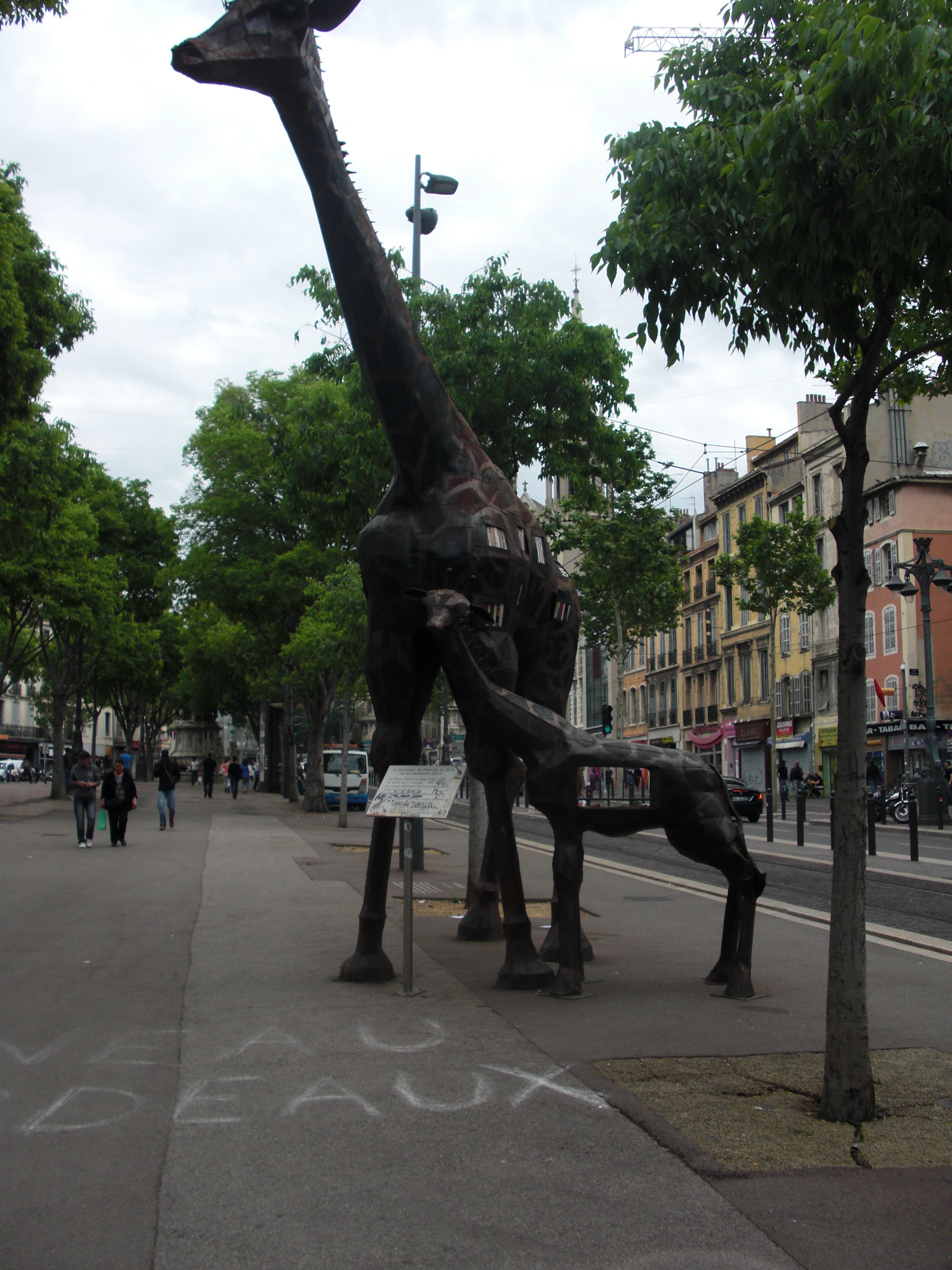
 It wasn't quite lunch time yet, so we strolled up the Canabière to the church of Saint Vincent de Paul and back. On the way, we got to watch several of the city's sleek new trolleys glide past (Marseille has an extensive subway, a system of busses, including some cute little electric ones, and trolley cars), and we encountered this pair of giraffes, clearly not among the identically shaped and variously painted ones scattered around the rest of the city. For one thing, they're truly life size (the others are maybe half); for another, they were clearly individually fabricated from sheet metal; and for a third, they were book cases! A plaque indicates that they were made for some sort of book festival, and as the right-hand photo shows, they have small, fully stocked bookshelves built right in, at a variety of odd angles. The baby giraffe's tummy, at about shoulder height and open on both sides, provided a few tattered volumes that passers-by were free to handle.
It wasn't quite lunch time yet, so we strolled up the Canabière to the church of Saint Vincent de Paul and back. On the way, we got to watch several of the city's sleek new trolleys glide past (Marseille has an extensive subway, a system of busses, including some cute little electric ones, and trolley cars), and we encountered this pair of giraffes, clearly not among the identically shaped and variously painted ones scattered around the rest of the city. For one thing, they're truly life size (the others are maybe half); for another, they were clearly individually fabricated from sheet metal; and for a third, they were book cases! A plaque indicates that they were made for some sort of book festival, and as the right-hand photo shows, they have small, fully stocked bookshelves built right in, at a variety of odd angles. The baby giraffe's tummy, at about shoulder height and open on both sides, provided a few tattered volumes that passers-by were free to handle.
I was beginning to think Marseille might have a special thing for giraffes (although not all the decorated fiberglas animals around here are the same; in addition to the rhino, we've seen at least one camel, but most are giraffes) even before I spotted something called the "Theater of the Giraffe" on the city map. I had vague memories of a story about a giraffe and a Mediterranean port, so once I got internet service, I looked it up. It seems that, back in 1826, Méhémet Ali (I don't know how that's rendered in English) sent the King of France, Charles X, a giraffe as a gift. Her name was Zarafa, and she was the very first giraffe to arrive in France. She came in through the port of Marseille, and because they couldn't come up with any better mode of transport, she and her handlers walked to Paris. Well, maybe the handlers rode horses, but she definitely walked. They took it in easy stages, and she was met by great acclaim, delight, and wonder by every village and town they passed through. She was less than a year old, apparently tame and gentle, and was hugely popular with the French people. The plaque accompanying the book-case giraffes says that the big one is "Zarafa III"
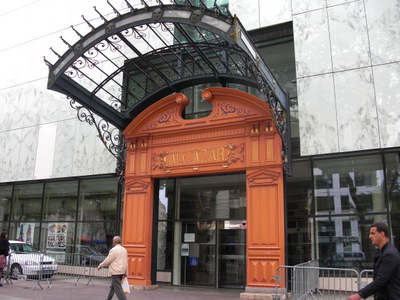
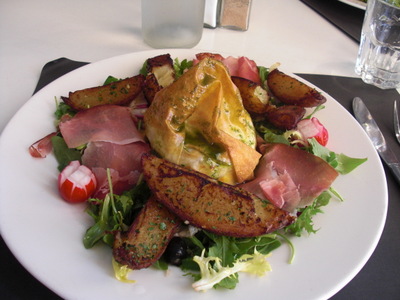 We made a detour to check out the Memorial to the Marseillaise, a museum celebrating the French national anthem, but it was closed. We also passed the famous and iconic Alcazar theater, but all that remains to be seen from ouside is the elaborate facade of the entryway and its antique cast-iron-and-glass canopy. The rest of the building has been reskinned in flat, featureless marble.
We made a detour to check out the Memorial to the Marseillaise, a museum celebrating the French national anthem, but it was closed. We also passed the famous and iconic Alcazar theater, but all that remains to be seen from ouside is the elaborate facade of the entryway and its antique cast-iron-and-glass canopy. The rest of the building has been reskinned in flat, featureless marble.
For lunch, we settled at La Brasserie, facing the Vieux Port. We both ordered the special salad of the day, shown here. They took a whole, young Saint Marcellin cheese, split it edgewise, sandwiched pine nuts inside, then pressed more pine nuts into the top and bottom surfaces before wrapping it loosely in buttered phyllo dough and baking it until it was crispy outside and melty inside. The whole thing was then plopped on top of la lightly dressed arugula salad with radishes, a couple of olives, and lots of crispy hot potato wedges, slices of raw ham, and a drizzle of herbed olive oil. Yummy, but too large to finish. For dessert, we broke into our little packet of tagada candies.
We'd been warned to show up early for the minibus tour, to get good seats, so we headed straight there, though it wasn't even 2 p.m., and it was just as well. We got the pair of seats that were together, fortunately partly shaded, as we then had to sit there for a solid half hour in the blazing sun in the roofless bus until departure time.
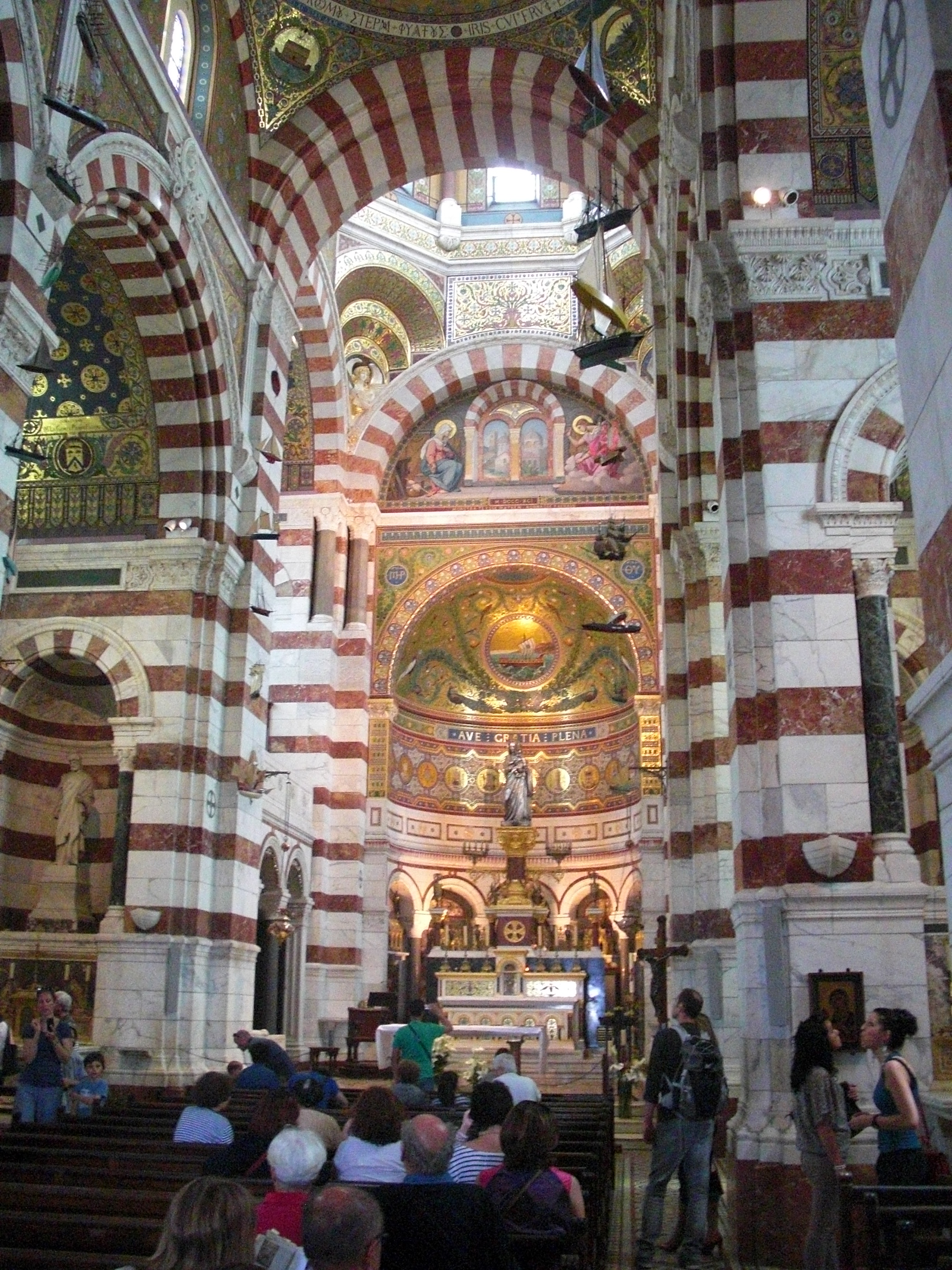
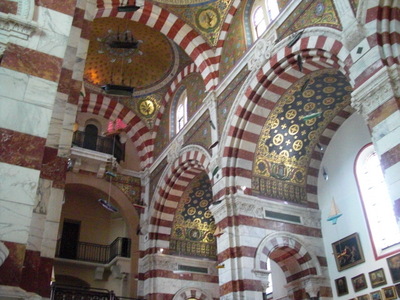 The tour was a pretty good one. Each seat was provided with a pair of little earbuds, individual volume control, and a choice of eight channels, which provided the narration in eight different languages, including Japanese. I chose French, and the sound track was very clear and easily followed. The tour lasted 2 hours, and hit all the high spots. The literal high spot was the Basilique de Notre Dame de la Garde, a sort of neo-Byzantine church perched on a limestone outcrop that towers over the city. Its tower is topped by a gigantic (nearly as large as the tower itself) gilded statue of the virgin Mary. Inside, it's very colorful, and the upper walls and ceilings are covered with glittering mosaics reminiscent of those at Sacré Coeur in Paris or the real Byzantine ones in Ravenna, Italy.
The tour was a pretty good one. Each seat was provided with a pair of little earbuds, individual volume control, and a choice of eight channels, which provided the narration in eight different languages, including Japanese. I chose French, and the sound track was very clear and easily followed. The tour lasted 2 hours, and hit all the high spots. The literal high spot was the Basilique de Notre Dame de la Garde, a sort of neo-Byzantine church perched on a limestone outcrop that towers over the city. Its tower is topped by a gigantic (nearly as large as the tower itself) gilded statue of the virgin Mary. Inside, it's very colorful, and the upper walls and ceilings are covered with glittering mosaics reminiscent of those at Sacré Coeur in Paris or the real Byzantine ones in Ravenna, Italy.
The place is, on the map, within a fairly easy walk of our hotel, but on the ground, it's not. The bus took us up (and up and up) a long way, to the foot of the building, then gave us 20 minutes to get out and visit it. From the bus, we then climbed 185 steps, just to reach the door to the (i.e., the basement) of the church. Next to a gate in one angle of the stairway a busker was playing Ave Maria very softly, with his fist stuffed into the bell of his French horn.
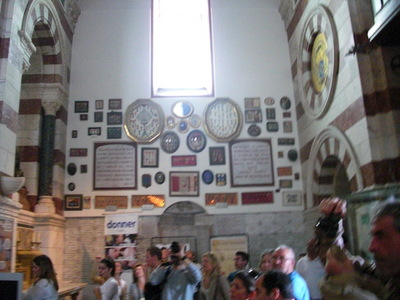
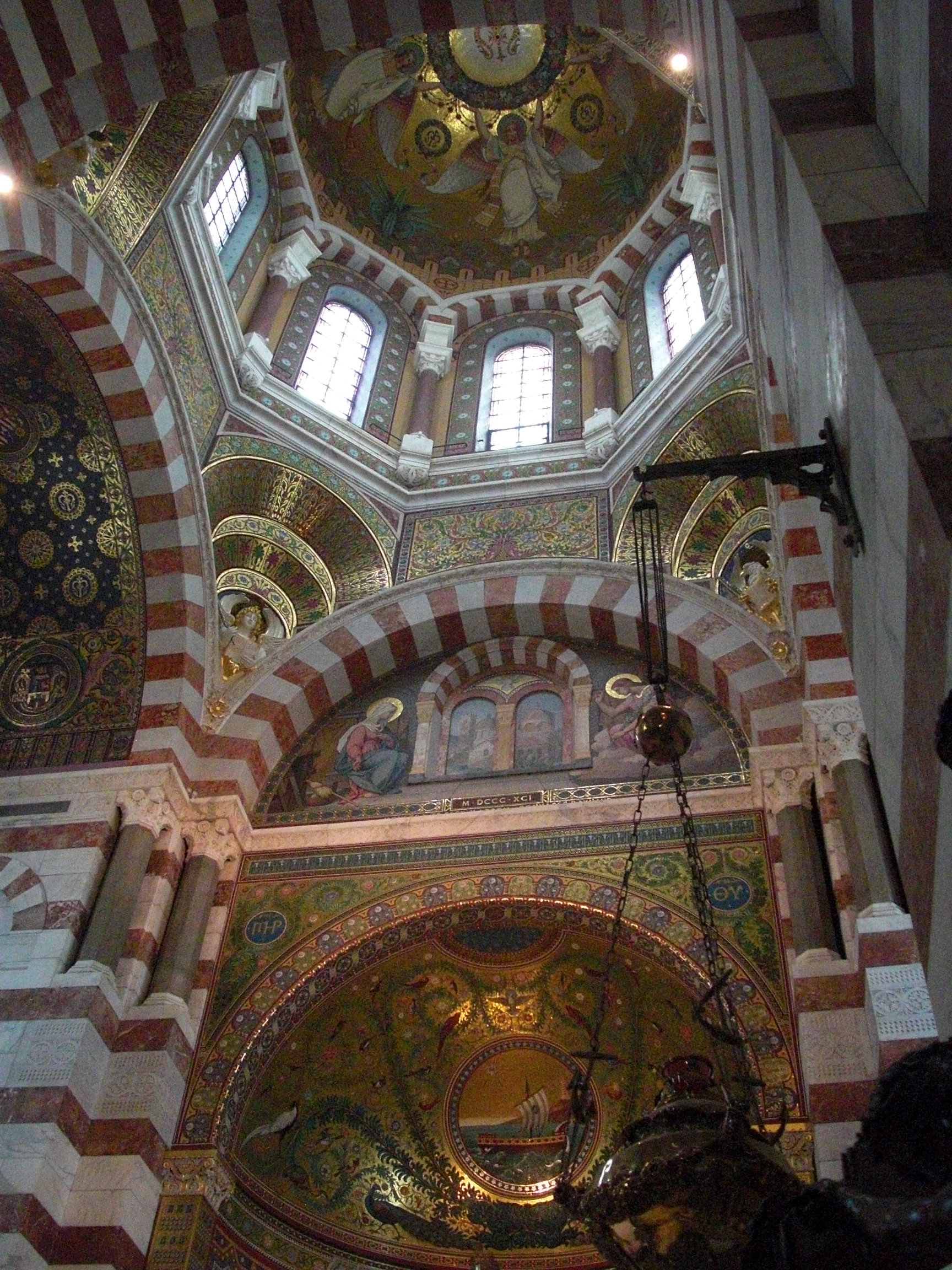 From the crypt, we then climbed a few more flights to reach the nave, where these photos were taken. The lower walls of the nave on both sides, are densely covered with "ex votos," little plaques offering thanks to the patron of the church (in this case Notre Dame de la Garde) for some boon (typically, recovery of a loved one from an illness or injury or someone's safe return from a voyage). Most, in this case, were little marble squares, maybe 8 by 8 inches, many just offering thanks but not specifying for what. Others were more elaborately worded or took the form of paintings or little sculptures. Some were memorial plaques, some of the largest given by, e.g., regiments commemorating the members lost in particular battles or wars. From the ceiling hung whole mobiles of model ships (and many of the paintings were of ships as well), understandable in a major seaport.
From the crypt, we then climbed a few more flights to reach the nave, where these photos were taken. The lower walls of the nave on both sides, are densely covered with "ex votos," little plaques offering thanks to the patron of the church (in this case Notre Dame de la Garde) for some boon (typically, recovery of a loved one from an illness or injury or someone's safe return from a voyage). Most, in this case, were little marble squares, maybe 8 by 8 inches, many just offering thanks but not specifying for what. Others were more elaborately worded or took the form of paintings or little sculptures. Some were memorial plaques, some of the largest given by, e.g., regiments commemorating the members lost in particular battles or wars. From the ceiling hung whole mobiles of model ships (and many of the paintings were of ships as well), understandable in a major seaport.
Unfortunately, we didn't have time to explore the place thoroughly (and it was packed shoulder to shoulder with tourists and pilgrims anyway) or to visit the crypt. We'd spend a fair amount of our 20 minutes climbing up there and had to reserve time to climb back down again (on knees that were feeling the effects of a couple of days on cobblestones; we'll get our "cobble legs" soon). Once everybody was accounted for, the bus set off again.
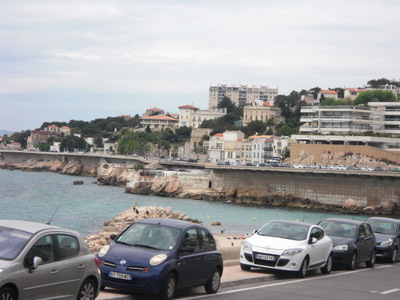
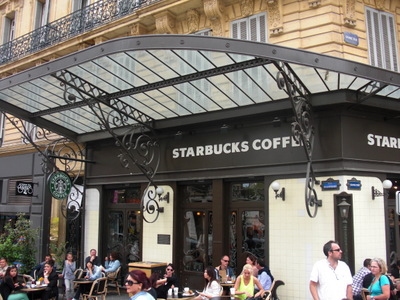 The "low point" of the tour, at least topographically, was our progress along the Marseille "Corniche," the seaside road. "Corniche" literally means "cornice," like the tiny ledge that runs around the top of a building. It was hard to photograph, especially from the moving bus, but I hope this view gives you an idea of the engineering involved. In some places, the roadbed was carved from the stone of the cliffs; in others, as here, it was cantilevered out over the water, with or without pilings to support the outer edge!
The "low point" of the tour, at least topographically, was our progress along the Marseille "Corniche," the seaside road. "Corniche" literally means "cornice," like the tiny ledge that runs around the top of a building. It was hard to photograph, especially from the moving bus, but I hope this view gives you an idea of the engineering involved. In some places, the roadbed was carved from the stone of the cliffs; in others, as here, it was cantilevered out over the water, with or without pilings to support the outer edge!
The low point culturally was this Starbucks, trying to fit in by having a traditional cast-iron-and-glass canopy over its door.
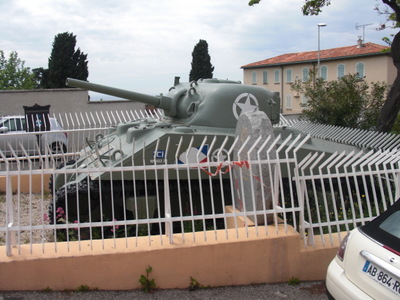
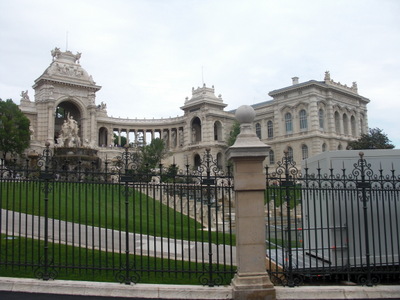 On the way back down the hill from the basilica, we passed this tank (which, but sheer luck, I got a perfectly framed photo of, shooting from the moving bus), which the narration did not mention but which the driver volunteered was the "char Jeanne d'Arc" (the "Joan of Arc tank") instrumental in the liberation of the basilica from the Germans. The French forces couldn't possibly bomb the basilica, so they took it by marching up the hill under fire. As I understand it, this tank was immobilized, and its crew killed, at this spot. We don't know whether "Jeanne d'Arc" was the model of tank, the name of this individual tank, or what. David says it looks like a Sherman.
On the way back down the hill from the basilica, we passed this tank (which, but sheer luck, I got a perfectly framed photo of, shooting from the moving bus), which the narration did not mention but which the driver volunteered was the "char Jeanne d'Arc" (the "Joan of Arc tank") instrumental in the liberation of the basilica from the Germans. The French forces couldn't possibly bomb the basilica, so they took it by marching up the hill under fire. As I understand it, this tank was immobilized, and its crew killed, at this spot. We don't know whether "Jeanne d'Arc" was the model of tank, the name of this individual tank, or what. David says it looks like a Sherman.
At the top of another hill, we saw the imposing structure shown to the right of the tank, the Palais Longchamps, which was actually built to serve as the city's water tower (European water towers are often embedded in hills rather than free-standing structures). The building on top now houses the Museum of Fine Arts and Museum of Natural History, both closed, of course, in preparation for next month's festivities.
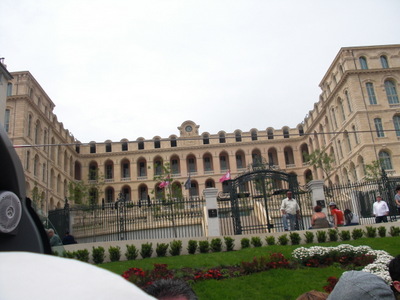
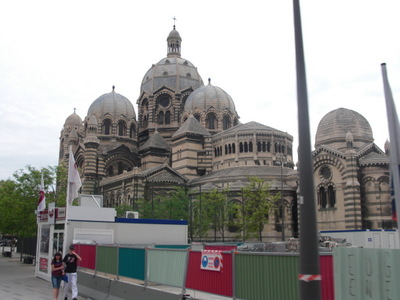 The last area the bus tour covered was north of the Vieux Port. On the way there, we saw (among other things) the Palais de Justice, the Prefecture (i.e., building housing the administration of the whole Marseille region), the city's train station, and the famous gigantic flight of stairs by which it is reached (hope they've installed elevators by now). In the northern section proper, we were shown the oldest building in Marseille (Medieval), the many renovations and constructions going on in preparation for June, the new docks that have replaced the Vieux Port for commercial traffic (the Vieux Port is now home to over 3000 pleasure craft and some small-boat fishermen), and the two buildings shown here. On the left is the enormous structure that was originally built as a charity hospital but now houses the Hotel Intercontinental. We can see the top of it from our side of the port and had wondered what it could be. On the right is the city's cathedral, built, as can be seen from the colors and architecture, by the same guy who did Notre Dame. We drove all the way around it, but we didn't stop or even slow down, and construction fences were everywhere. Out of about a dozen, this is the shot that got the most parts of the building into the frame.
The last area the bus tour covered was north of the Vieux Port. On the way there, we saw (among other things) the Palais de Justice, the Prefecture (i.e., building housing the administration of the whole Marseille region), the city's train station, and the famous gigantic flight of stairs by which it is reached (hope they've installed elevators by now). In the northern section proper, we were shown the oldest building in Marseille (Medieval), the many renovations and constructions going on in preparation for June, the new docks that have replaced the Vieux Port for commercial traffic (the Vieux Port is now home to over 3000 pleasure craft and some small-boat fishermen), and the two buildings shown here. On the left is the enormous structure that was originally built as a charity hospital but now houses the Hotel Intercontinental. We can see the top of it from our side of the port and had wondered what it could be. On the right is the city's cathedral, built, as can be seen from the colors and architecture, by the same guy who did Notre Dame. We drove all the way around it, but we didn't stop or even slow down, and construction fences were everywhere. Out of about a dozen, this is the shot that got the most parts of the building into the frame.
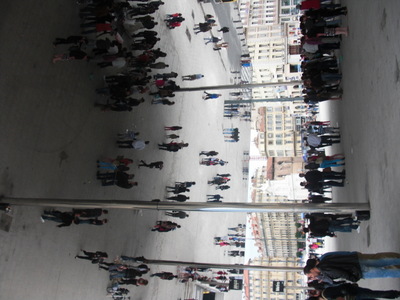
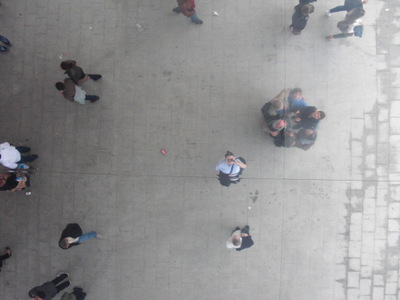 Our dinner was at Une Table au Sud (Gault-Millau 3/5), which overlooked the Vieux Port and where we will dine three times in all on this trip. On our way there, strolling across the broad promenade at the head of the port, I finally took the opportunity to try to photograph the gigantic shade structure placed there, presumably for the convenience of the crowds that routinely wait there for cruises around the harbor, to the Chateau d'If, or to the calanques (nearby very scenic Mediterranean "fjords"). It's also popular with buskers, artists who paint while you watch, mimes, etc. What makes the structure fascinating is that its ceiling is mirrored. Looking straight up, the reflections seem pretty true, whereas from farther away, edge on, as it were, they are slightly rippled and recall a reflecting pool in a breeze.
Our dinner was at Une Table au Sud (Gault-Millau 3/5), which overlooked the Vieux Port and where we will dine three times in all on this trip. On our way there, strolling across the broad promenade at the head of the port, I finally took the opportunity to try to photograph the gigantic shade structure placed there, presumably for the convenience of the crowds that routinely wait there for cruises around the harbor, to the Chateau d'If, or to the calanques (nearby very scenic Mediterranean "fjords"). It's also popular with buskers, artists who paint while you watch, mimes, etc. What makes the structure fascinating is that its ceiling is mirrored. Looking straight up, the reflections seem pretty true, whereas from farther away, edge on, as it were, they are slightly rippled and recall a reflecting pool in a breeze.
At the left is a shot of the people walking underneath it and their reflections in the ceiling. At the right is a photo I took of myself, looking straight up. Just below my image is the reflection of David, edging away in embarrassment. I got the idea from the group of six people a little to the right of me, who formed a tight circle and took their own photo, looking straight up. Fun!
Written Saturday, 11 May 2013
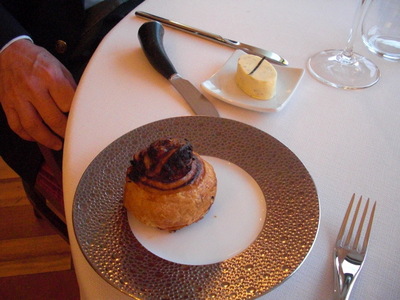
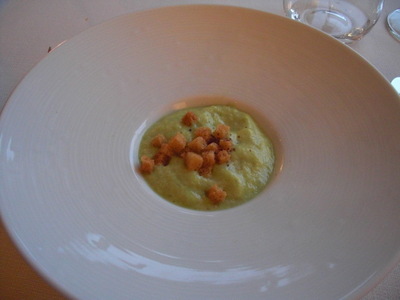 At street level, our restaurant, Une Table Au Sud is just a narrow doorway sandwiched between a Hagen Dazs dipping store and a huge brasserie of no great distinction, but up one flight we found the elegant dining room with broad, sparkling clean windows looking out over the Vieux Port. The first amuse bouche, brought even before we saw the menu, was this crispy spiral bun made with croissant dough rolled around slow-cooked caramelized onion and whole mustard seeds. It was served with a house-made compound butter flavored with three species of algae and lime juice. Yummy.
At street level, our restaurant, Une Table Au Sud is just a narrow doorway sandwiched between a Hagen Dazs dipping store and a huge brasserie of no great distinction, but up one flight we found the elegant dining room with broad, sparkling clean windows looking out over the Vieux Port. The first amuse bouche, brought even before we saw the menu, was this crispy spiral bun made with croissant dough rolled around slow-cooked caramelized onion and whole mustard seeds. It was served with a house-made compound butter flavored with three species of algae and lime juice. Yummy.
The second amuse-bouche, served after we ordered, was a chilled soufflé of green peas flavored with anchovy oil and sprinkled with tiny croutons fried in olive oil. The anchovy flavor was so subtle that David was not bothered by it.
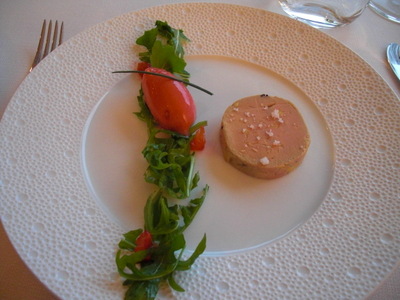
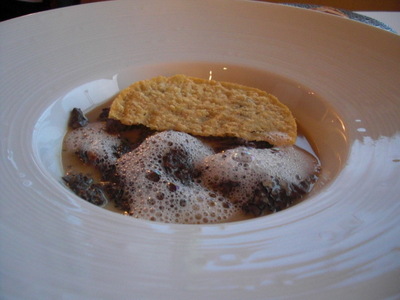 First course, David: Morels fricasseed with Tio Pepe and bacon and topped with a Parmesan crisp. Outstanding!
First course, David: Morels fricasseed with Tio Pepe and bacon and topped with a Parmesan crisp. Outstanding!
First course, me: Cold "smoked" confit of foie gras, sprinkled with coarse salt and accompanied by a little salad of arugula, a quenelle of blood-orange sorbet, and bits of blood orange flesh. Excellent. The sorbet was not too sweet and had a good deal of the peel oil in it. A fine starter altogether, but next time we order à la carte at that place, I'm getting the morels!
While we enjoyed our first courses, we spotted a UFO over the Vieux Port, which, when it came in for a landing on the better-lighted quai, we could identify as a radio-controlled toy helicopter covered with colored lights.
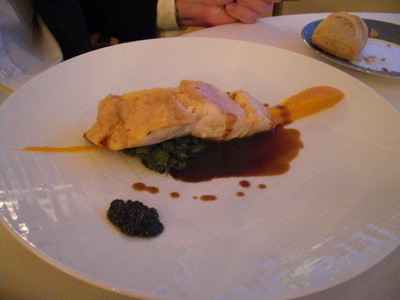
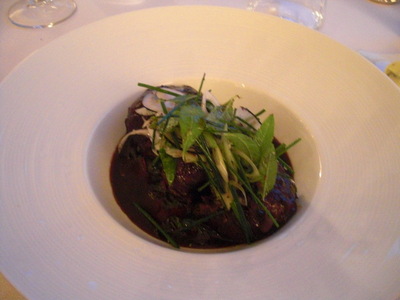 Main course: David: Fish on a bed of "acidulated" cress, accompanied by a streak of sweet potato purée, osietre caviare on the side. The menu said "local loup de mer" (Dicentrarchus labrax, also called "bar" in French), but when he ordered, the waitress specified that the didn't have loup de mer that evening and instead were serving "denti." Never heard of it, but David declared it delicious; "meatier" than loup de mer. Subsequent research (I love the internet) revealed that it was Dentex dentex, a toothy close relative of loup de mer, apparently called just "dentex" or "common dentex" in English.
Main course: David: Fish on a bed of "acidulated" cress, accompanied by a streak of sweet potato purée, osietre caviare on the side. The menu said "local loup de mer" (Dicentrarchus labrax, also called "bar" in French), but when he ordered, the waitress specified that the didn't have loup de mer that evening and instead were serving "denti." Never heard of it, but David declared it delicious; "meatier" than loup de mer. Subsequent research (I love the internet) revealed that it was Dentex dentex, a toothy close relative of loup de mer, apparently called just "dentex" or "common dentex" in English.
Main course, me: Slow-braised pork cheeks on a bed of Swiss chard and topped with a little salad of chives, scallions, and lemon verbena. The pork was wonderful, meltingly tender and succulent without being sticky with collagen, and surrounded by a deeply flavored braising sauce. Yes, I know it's a fish town, but how often do you get the chance for pork cheeks?
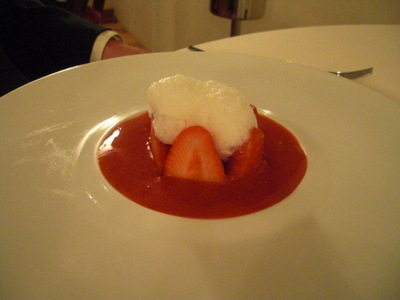
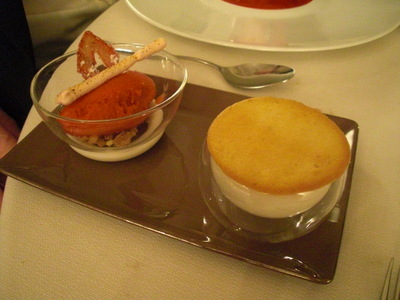 Dessert, David: Deconstructed strawberry tart. On one plate, he got a crown of strawberries topped with a white foam. On another, were a quenelle of strawberry sorbet resting on pastry crumbles and topped with a crisp strawberry "chip" and a meringue baton (the white band was just a rubber ring used to allow the hemispherical bowl to stand steady) and a bowl of vanilla-flavored yogurt-based custard topped with a thin tender cookie. The waiter explained that, if David could manage to get a little of everything into the same spoonful, it would add up to a strawberry tart!
Dessert, David: Deconstructed strawberry tart. On one plate, he got a crown of strawberries topped with a white foam. On another, were a quenelle of strawberry sorbet resting on pastry crumbles and topped with a crisp strawberry "chip" and a meringue baton (the white band was just a rubber ring used to allow the hemispherical bowl to stand steady) and a bowl of vanilla-flavored yogurt-based custard topped with a thin tender cookie. The waiter explained that, if David could manage to get a little of everything into the same spoonful, it would add up to a strawberry tart!
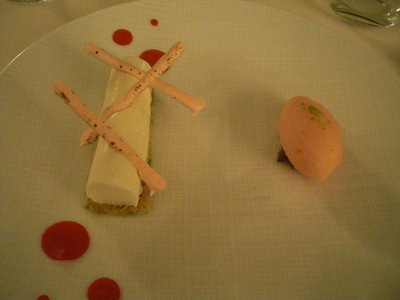
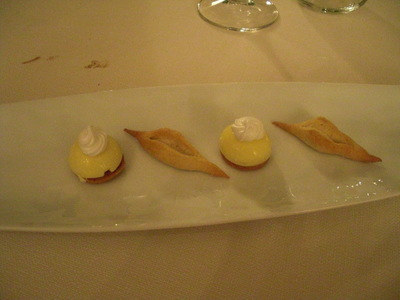 Dessert, me: chilled pistachio and grapefruit parfait with acidulated meringue. A cylinder of chilled grapefruit cream (panna cotta?) was laid on a sheet of pistachio cake and topped with little batons of meringue that were somewhat tangy as well as sugary. On the side, a quenelle of pink grapefruit sorbet on a bed of pistachios. The red polka dots were cut from a very thin layer of jellied red substance and then laid in place on the plate. Delicious!
Dessert, me: chilled pistachio and grapefruit parfait with acidulated meringue. A cylinder of chilled grapefruit cream (panna cotta?) was laid on a sheet of pistachio cake and topped with little batons of meringue that were somewhat tangy as well as sugary. On the side, a quenelle of pink grapefruit sorbet on a bed of pistachios. The red polka dots were cut from a very thin layer of jellied red substance and then laid in place on the plate. Delicious!
The mignardises were miniature versions of little boat-shaped cookies that Marseille is known for and miniature, very tangy, dome-shaped lemon tarts.
When we order a surprise tasting menu, especially when CJ is with us, I often feel as though we're awfully hard to please—no melon, no cucumber, no avocado, no nuts of any kind, etc., etc. But the table next to us at Une Table au Sud had it worse. They were five young people, all of whom looked Indian and who spoke English among themselves in a variety of Indian, English, and American accents. I assume the group included both Hindus and Muslims, because they ordered the five-course suprise menu and started buy specifying no beef and no pork. The slightly older guy that I thought of a the host ate meat but no fish. One of the other guys ate only fish and vegetables. The two of them drank wine, but the others wanted no alcohol (they started with rainbow colored Shirley Temples, then progressed to Coke and orange juice). We didn't see the entire progress of their dinner, but the host got an empty plate during one fish course and what looked like roast pigeon during another. Fancy French kitchens are really very accommodating.
previous entry
List of Entries
next entry
 Here's my choice from the entirely satisfactory all-you-can-eat breakfast buffet: A cup of café au lait (i.e., a packet of instant decaf made up with hot milk rather than water—in this case, five presses of the "hot milk" button on the hot drink dispenser), two packets of sugar, three packets of excellent demi-sel butter (ah, real French butter!), a tubular squeeze-pack of apricot jam, two chunks of fresh baguette (which I cut myself to the size of my choice), a single-serve packet containing a thin wedge of "tomme noir" cheese (like havarti in the center but like swiss near the rind), a small but outstanding croissant, and a cup of chilled water. Later, I went back for a second croissant and another pat of butter. Also available were apple and orange juices (from a dispenser), single-serve cups of applesauce and plain yogurt, two kinds of dry cereal, cold milk, a bowl of cut-up fresh fruit, sliced bread (with toaster), cut-it-yourself whole-grain bread in square cushion-shaped loaves, slices of pound cake, tubes of strawberry jam, single-serve packets of honey and Nutella. The hot drink dispenser also did hot water (teabags supplied), espresso, hot chocolate, and "extended" (i.e., dilute enough for Americans) coffee. No plates or forks were supplied—just these green masonite trays, coffee cups, and stainless-steel knives and spoons. The napkins, juice/water cups, and cereal bowls were all disposable. No noninstant decaf, no eggs (either cooked or boil-'em-yourself), no cold cuts, no potato tortilla, no pains au chocolat or aux raisins. So, all in all, a spartan rather than a middling or sumptuous breakfast buffet, but the products supplied were uniformly outstanding. I look forward already to tomorrow's rerun of the same menu, though I may substitute one of the little yogurts, with honey, for the cheese wedge.
Here's my choice from the entirely satisfactory all-you-can-eat breakfast buffet: A cup of café au lait (i.e., a packet of instant decaf made up with hot milk rather than water—in this case, five presses of the "hot milk" button on the hot drink dispenser), two packets of sugar, three packets of excellent demi-sel butter (ah, real French butter!), a tubular squeeze-pack of apricot jam, two chunks of fresh baguette (which I cut myself to the size of my choice), a single-serve packet containing a thin wedge of "tomme noir" cheese (like havarti in the center but like swiss near the rind), a small but outstanding croissant, and a cup of chilled water. Later, I went back for a second croissant and another pat of butter. Also available were apple and orange juices (from a dispenser), single-serve cups of applesauce and plain yogurt, two kinds of dry cereal, cold milk, a bowl of cut-up fresh fruit, sliced bread (with toaster), cut-it-yourself whole-grain bread in square cushion-shaped loaves, slices of pound cake, tubes of strawberry jam, single-serve packets of honey and Nutella. The hot drink dispenser also did hot water (teabags supplied), espresso, hot chocolate, and "extended" (i.e., dilute enough for Americans) coffee. No plates or forks were supplied—just these green masonite trays, coffee cups, and stainless-steel knives and spoons. The napkins, juice/water cups, and cereal bowls were all disposable. No noninstant decaf, no eggs (either cooked or boil-'em-yourself), no cold cuts, no potato tortilla, no pains au chocolat or aux raisins. So, all in all, a spartan rather than a middling or sumptuous breakfast buffet, but the products supplied were uniformly outstanding. I look forward already to tomorrow's rerun of the same menu, though I may substitute one of the little yogurts, with honey, for the cheese wedge.
 It wasn't quite lunch time yet, so we strolled up the Canabière to the church of Saint Vincent de Paul and back. On the way, we got to watch several of the city's sleek new trolleys glide past (Marseille has an extensive subway, a system of busses, including some cute little electric ones, and trolley cars), and we encountered this pair of giraffes, clearly not among the identically shaped and variously painted ones scattered around the rest of the city. For one thing, they're truly life size (the others are maybe half); for another, they were clearly individually fabricated from sheet metal; and for a third, they were book cases! A plaque indicates that they were made for some sort of book festival, and as the right-hand photo shows, they have small, fully stocked bookshelves built right in, at a variety of odd angles. The baby giraffe's tummy, at about shoulder height and open on both sides, provided a few tattered volumes that passers-by were free to handle.
It wasn't quite lunch time yet, so we strolled up the Canabière to the church of Saint Vincent de Paul and back. On the way, we got to watch several of the city's sleek new trolleys glide past (Marseille has an extensive subway, a system of busses, including some cute little electric ones, and trolley cars), and we encountered this pair of giraffes, clearly not among the identically shaped and variously painted ones scattered around the rest of the city. For one thing, they're truly life size (the others are maybe half); for another, they were clearly individually fabricated from sheet metal; and for a third, they were book cases! A plaque indicates that they were made for some sort of book festival, and as the right-hand photo shows, they have small, fully stocked bookshelves built right in, at a variety of odd angles. The baby giraffe's tummy, at about shoulder height and open on both sides, provided a few tattered volumes that passers-by were free to handle.
 We made a detour to check out the Memorial to the Marseillaise, a museum celebrating the French national anthem, but it was closed. We also passed the famous and iconic Alcazar theater, but all that remains to be seen from ouside is the elaborate facade of the entryway and its antique cast-iron-and-glass canopy. The rest of the building has been reskinned in flat, featureless marble.
We made a detour to check out the Memorial to the Marseillaise, a museum celebrating the French national anthem, but it was closed. We also passed the famous and iconic Alcazar theater, but all that remains to be seen from ouside is the elaborate facade of the entryway and its antique cast-iron-and-glass canopy. The rest of the building has been reskinned in flat, featureless marble.
 The tour was a pretty good one. Each seat was provided with a pair of little earbuds, individual volume control, and a choice of eight channels, which provided the narration in eight different languages, including Japanese. I chose French, and the sound track was very clear and easily followed. The tour lasted 2 hours, and hit all the high spots. The literal high spot was the Basilique de Notre Dame de la Garde, a sort of neo-Byzantine church perched on a limestone outcrop that towers over the city. Its tower is topped by a gigantic (nearly as large as the tower itself) gilded statue of the virgin Mary. Inside, it's very colorful, and the upper walls and ceilings are covered with glittering mosaics reminiscent of those at Sacré Coeur in Paris or the real Byzantine ones in Ravenna, Italy.
The tour was a pretty good one. Each seat was provided with a pair of little earbuds, individual volume control, and a choice of eight channels, which provided the narration in eight different languages, including Japanese. I chose French, and the sound track was very clear and easily followed. The tour lasted 2 hours, and hit all the high spots. The literal high spot was the Basilique de Notre Dame de la Garde, a sort of neo-Byzantine church perched on a limestone outcrop that towers over the city. Its tower is topped by a gigantic (nearly as large as the tower itself) gilded statue of the virgin Mary. Inside, it's very colorful, and the upper walls and ceilings are covered with glittering mosaics reminiscent of those at Sacré Coeur in Paris or the real Byzantine ones in Ravenna, Italy.
 From the crypt, we then climbed a few more flights to reach the nave, where these photos were taken. The lower walls of the nave on both sides, are densely covered with "ex votos," little plaques offering thanks to the patron of the church (in this case Notre Dame de la Garde) for some boon (typically, recovery of a loved one from an illness or injury or someone's safe return from a voyage). Most, in this case, were little marble squares, maybe 8 by 8 inches, many just offering thanks but not specifying for what. Others were more elaborately worded or took the form of paintings or little sculptures. Some were memorial plaques, some of the largest given by, e.g., regiments commemorating the members lost in particular battles or wars. From the ceiling hung whole mobiles of model ships (and many of the paintings were of ships as well), understandable in a major seaport.
From the crypt, we then climbed a few more flights to reach the nave, where these photos were taken. The lower walls of the nave on both sides, are densely covered with "ex votos," little plaques offering thanks to the patron of the church (in this case Notre Dame de la Garde) for some boon (typically, recovery of a loved one from an illness or injury or someone's safe return from a voyage). Most, in this case, were little marble squares, maybe 8 by 8 inches, many just offering thanks but not specifying for what. Others were more elaborately worded or took the form of paintings or little sculptures. Some were memorial plaques, some of the largest given by, e.g., regiments commemorating the members lost in particular battles or wars. From the ceiling hung whole mobiles of model ships (and many of the paintings were of ships as well), understandable in a major seaport.
 The "low point" of the tour, at least topographically, was our progress along the Marseille "Corniche," the seaside road. "Corniche" literally means "cornice," like the tiny ledge that runs around the top of a building. It was hard to photograph, especially from the moving bus, but I hope this view gives you an idea of the engineering involved. In some places, the roadbed was carved from the stone of the cliffs; in others, as here, it was cantilevered out over the water, with or without pilings to support the outer edge!
The "low point" of the tour, at least topographically, was our progress along the Marseille "Corniche," the seaside road. "Corniche" literally means "cornice," like the tiny ledge that runs around the top of a building. It was hard to photograph, especially from the moving bus, but I hope this view gives you an idea of the engineering involved. In some places, the roadbed was carved from the stone of the cliffs; in others, as here, it was cantilevered out over the water, with or without pilings to support the outer edge!
 On the way back down the hill from the basilica, we passed this tank (which, but sheer luck, I got a perfectly framed photo of, shooting from the moving bus), which the narration did not mention but which the driver volunteered was the "char Jeanne d'Arc" (the "Joan of Arc tank") instrumental in the liberation of the basilica from the Germans. The French forces couldn't possibly bomb the basilica, so they took it by marching up the hill under fire. As I understand it, this tank was immobilized, and its crew killed, at this spot. We don't know whether "Jeanne d'Arc" was the model of tank, the name of this individual tank, or what. David says it looks like a Sherman.
On the way back down the hill from the basilica, we passed this tank (which, but sheer luck, I got a perfectly framed photo of, shooting from the moving bus), which the narration did not mention but which the driver volunteered was the "char Jeanne d'Arc" (the "Joan of Arc tank") instrumental in the liberation of the basilica from the Germans. The French forces couldn't possibly bomb the basilica, so they took it by marching up the hill under fire. As I understand it, this tank was immobilized, and its crew killed, at this spot. We don't know whether "Jeanne d'Arc" was the model of tank, the name of this individual tank, or what. David says it looks like a Sherman.
 The last area the bus tour covered was north of the Vieux Port. On the way there, we saw (among other things) the Palais de Justice, the Prefecture (i.e., building housing the administration of the whole Marseille region), the city's train station, and the famous gigantic flight of stairs by which it is reached (hope they've installed elevators by now). In the northern section proper, we were shown the oldest building in Marseille (Medieval), the many renovations and constructions going on in preparation for June, the new docks that have replaced the Vieux Port for commercial traffic (the Vieux Port is now home to over 3000 pleasure craft and some small-boat fishermen), and the two buildings shown here. On the left is the enormous structure that was originally built as a charity hospital but now houses the Hotel Intercontinental. We can see the top of it from our side of the port and had wondered what it could be. On the right is the city's cathedral, built, as can be seen from the colors and architecture, by the same guy who did Notre Dame. We drove all the way around it, but we didn't stop or even slow down, and construction fences were everywhere. Out of about a dozen, this is the shot that got the most parts of the building into the frame.
The last area the bus tour covered was north of the Vieux Port. On the way there, we saw (among other things) the Palais de Justice, the Prefecture (i.e., building housing the administration of the whole Marseille region), the city's train station, and the famous gigantic flight of stairs by which it is reached (hope they've installed elevators by now). In the northern section proper, we were shown the oldest building in Marseille (Medieval), the many renovations and constructions going on in preparation for June, the new docks that have replaced the Vieux Port for commercial traffic (the Vieux Port is now home to over 3000 pleasure craft and some small-boat fishermen), and the two buildings shown here. On the left is the enormous structure that was originally built as a charity hospital but now houses the Hotel Intercontinental. We can see the top of it from our side of the port and had wondered what it could be. On the right is the city's cathedral, built, as can be seen from the colors and architecture, by the same guy who did Notre Dame. We drove all the way around it, but we didn't stop or even slow down, and construction fences were everywhere. Out of about a dozen, this is the shot that got the most parts of the building into the frame.
 Our dinner was at Une Table au Sud (Gault-Millau 3/5), which overlooked the Vieux Port and where we will dine three times in all on this trip. On our way there, strolling across the broad promenade at the head of the port, I finally took the opportunity to try to photograph the gigantic shade structure placed there, presumably for the convenience of the crowds that routinely wait there for cruises around the harbor, to the Chateau d'If, or to the calanques (nearby very scenic Mediterranean "fjords"). It's also popular with buskers, artists who paint while you watch, mimes, etc. What makes the structure fascinating is that its ceiling is mirrored. Looking straight up, the reflections seem pretty true, whereas from farther away, edge on, as it were, they are slightly rippled and recall a reflecting pool in a breeze.
Our dinner was at Une Table au Sud (Gault-Millau 3/5), which overlooked the Vieux Port and where we will dine three times in all on this trip. On our way there, strolling across the broad promenade at the head of the port, I finally took the opportunity to try to photograph the gigantic shade structure placed there, presumably for the convenience of the crowds that routinely wait there for cruises around the harbor, to the Chateau d'If, or to the calanques (nearby very scenic Mediterranean "fjords"). It's also popular with buskers, artists who paint while you watch, mimes, etc. What makes the structure fascinating is that its ceiling is mirrored. Looking straight up, the reflections seem pretty true, whereas from farther away, edge on, as it were, they are slightly rippled and recall a reflecting pool in a breeze.
 At street level, our restaurant, Une Table Au Sud is just a narrow doorway sandwiched between a Hagen Dazs dipping store and a huge brasserie of no great distinction, but up one flight we found the elegant dining room with broad, sparkling clean windows looking out over the Vieux Port. The first amuse bouche, brought even before we saw the menu, was this crispy spiral bun made with croissant dough rolled around slow-cooked caramelized onion and whole mustard seeds. It was served with a house-made compound butter flavored with three species of algae and lime juice. Yummy.
At street level, our restaurant, Une Table Au Sud is just a narrow doorway sandwiched between a Hagen Dazs dipping store and a huge brasserie of no great distinction, but up one flight we found the elegant dining room with broad, sparkling clean windows looking out over the Vieux Port. The first amuse bouche, brought even before we saw the menu, was this crispy spiral bun made with croissant dough rolled around slow-cooked caramelized onion and whole mustard seeds. It was served with a house-made compound butter flavored with three species of algae and lime juice. Yummy.
 First course, David: Morels fricasseed with Tio Pepe and bacon and topped with a Parmesan crisp. Outstanding!
First course, David: Morels fricasseed with Tio Pepe and bacon and topped with a Parmesan crisp. Outstanding! 
 Main course: David: Fish on a bed of "acidulated" cress, accompanied by a streak of sweet potato purée, osietre caviare on the side. The menu said "local loup de mer" (Dicentrarchus labrax, also called "bar" in French), but when he ordered, the waitress specified that the didn't have loup de mer that evening and instead were serving "denti." Never heard of it, but David declared it delicious; "meatier" than loup de mer. Subsequent research (I love the internet) revealed that it was Dentex dentex, a toothy close relative of loup de mer, apparently called just "dentex" or "common dentex" in English.
Main course: David: Fish on a bed of "acidulated" cress, accompanied by a streak of sweet potato purée, osietre caviare on the side. The menu said "local loup de mer" (Dicentrarchus labrax, also called "bar" in French), but when he ordered, the waitress specified that the didn't have loup de mer that evening and instead were serving "denti." Never heard of it, but David declared it delicious; "meatier" than loup de mer. Subsequent research (I love the internet) revealed that it was Dentex dentex, a toothy close relative of loup de mer, apparently called just "dentex" or "common dentex" in English.
 Dessert, David: Deconstructed strawberry tart. On one plate, he got a crown of strawberries topped with a white foam. On another, were a quenelle of strawberry sorbet resting on pastry crumbles and topped with a crisp strawberry "chip" and a meringue baton (the white band was just a rubber ring used to allow the hemispherical bowl to stand steady) and a bowl of vanilla-flavored yogurt-based custard topped with a thin tender cookie. The waiter explained that, if David could manage to get a little of everything into the same spoonful, it would add up to a strawberry tart!
Dessert, David: Deconstructed strawberry tart. On one plate, he got a crown of strawberries topped with a white foam. On another, were a quenelle of strawberry sorbet resting on pastry crumbles and topped with a crisp strawberry "chip" and a meringue baton (the white band was just a rubber ring used to allow the hemispherical bowl to stand steady) and a bowl of vanilla-flavored yogurt-based custard topped with a thin tender cookie. The waiter explained that, if David could manage to get a little of everything into the same spoonful, it would add up to a strawberry tart!
 Dessert, me: chilled pistachio and grapefruit parfait with acidulated meringue. A cylinder of chilled grapefruit cream (panna cotta?) was laid on a sheet of pistachio cake and topped with little batons of meringue that were somewhat tangy as well as sugary. On the side, a quenelle of pink grapefruit sorbet on a bed of pistachios. The red polka dots were cut from a very thin layer of jellied red substance and then laid in place on the plate. Delicious!
Dessert, me: chilled pistachio and grapefruit parfait with acidulated meringue. A cylinder of chilled grapefruit cream (panna cotta?) was laid on a sheet of pistachio cake and topped with little batons of meringue that were somewhat tangy as well as sugary. On the side, a quenelle of pink grapefruit sorbet on a bed of pistachios. The red polka dots were cut from a very thin layer of jellied red substance and then laid in place on the plate. Delicious!